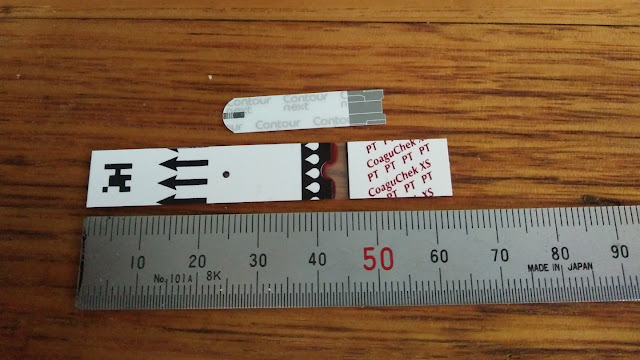The Roche CoaguChek is pretty much the backbone of my personal self management of my INR. I have on many occasions discussed that I compare it to the lab and often get quite good (less than 0.2INR units) correlation with labs. This is something which is occasionally still debated (particularly on the internet) but which to my mind was put to bed back in 2012 with many comparisons of its accuracy vs that of other systems. So I'll not waste your time and repeat that here.
Determining INR is based on measuring the time taken for "coagulation" to occur.
Note: That's a minefield right there, so lets just leave it simply at: a timer is started and stopped when the machine determines coagulation is "completed" (*according to guidelines like reagent ISI, another rabbit hole for you the curious).
The CoaguChek uses "amperometric electrochemical" methods for determining the time to declare the point of "coagulation" to stop the timer. A good summary of this and other methods is here (link).
So having swept that detail off the table, I wanted to get down to exploring a little bit about the CoaguChek XS system which we can easily see, but may not have noticed (even if you've used one).
First, lets have a quick look at the strips, they are much bigger than the strips used by Blood Glucose monitoring strips. Shown below.
Obviously the strips above are used because I prefer not to risk contaminating them for photography and so you'll see traces of my blood in these images. Note that circular hole in the strip at about the 24mm point. I'll circle back to that.
This video gives a quick walkthrough of the XS.
As you saw in that video the CoaguChek strips have three layers of plastic, seen in the image below.
The top printed layer is white, in the middle is a black layer which is used to form the blood capillary tube and then there is a clear base layer (which I'll call the substrate). I can't measure the thickness of the black layer, but I used my trusty digital callipers to measure what I could and thus determine the thickness of black layer. The thicknesses of the strip will tell us about the thickness of the blood channel
- white part is 0.36mm
- the clear base is 0.35mm
- the entire width of the strip 0.89mm
Now we know that Amperometric analysis is used and (from this obscure source) know that the XS system uses a lyophilized reagent (reagent in dried form). The reactive components of this reagent consist of thromboplastin and a peptide substrate. In that above link (here again) chapter 5.3 is of relevance to the CoaguChek XS. But basically the blood needs to flow past the thromboplastin reagent and starting the process. You can see where it goes in and where it ends up in this picture of the underside.
Note that hole, it allows air out of the tube as the capillary attraction to pulls the blood through (from where you placed it) and across the chemistry; through to the area where the sensing occurs. You can see this below too.
The hole is needed to allow the blood to flow right through this channel, were it not there air pockets would form and stop the blood completing the journey. I assume that a light shone through the hole indicates that sufficient blood has now reached the end of the channel. [PS: subsequently I found this theory may be wrong see end PS]
You can see clearly below that it is a hole from below
So from all of this we see how the blood flows, why you need to put the blood on the top of the strip, or if you use the side (also mentioned in the documentation). From the Roche CoaguChek XS manual:
Exploring the 15 Second rule and outcomes
Summary
Basically after watching those videos and reading the above you should know more about:
- how to use your CoaguChek XS device effectively
- be in a better situation to understand why they make a lot of points again and again in the manual like 15 second rule and application of blood, and preparing your finger for getting a good blood sample
- You should also be able to dismiss any misinformation you may read on the internet (such as how the blood could coagulate clumps could and block the flow)
- from a logical perspective of how the whole system works both physically (the capillary attraction) and the way the machine knows sufficient blood is present.
Knowledge is power and freedom from the anxiety which stems from ignorance.
HTH
PS
I recently carefully washed the blood out of a used strip to have a better look
you can see that there are contacts in places which would provide feedback as to blood having reached the far end of the channel as well as perhaps an area which is used to determine coagulation operation.
Quite interesting.















.jpg)



No comments:
Post a Comment